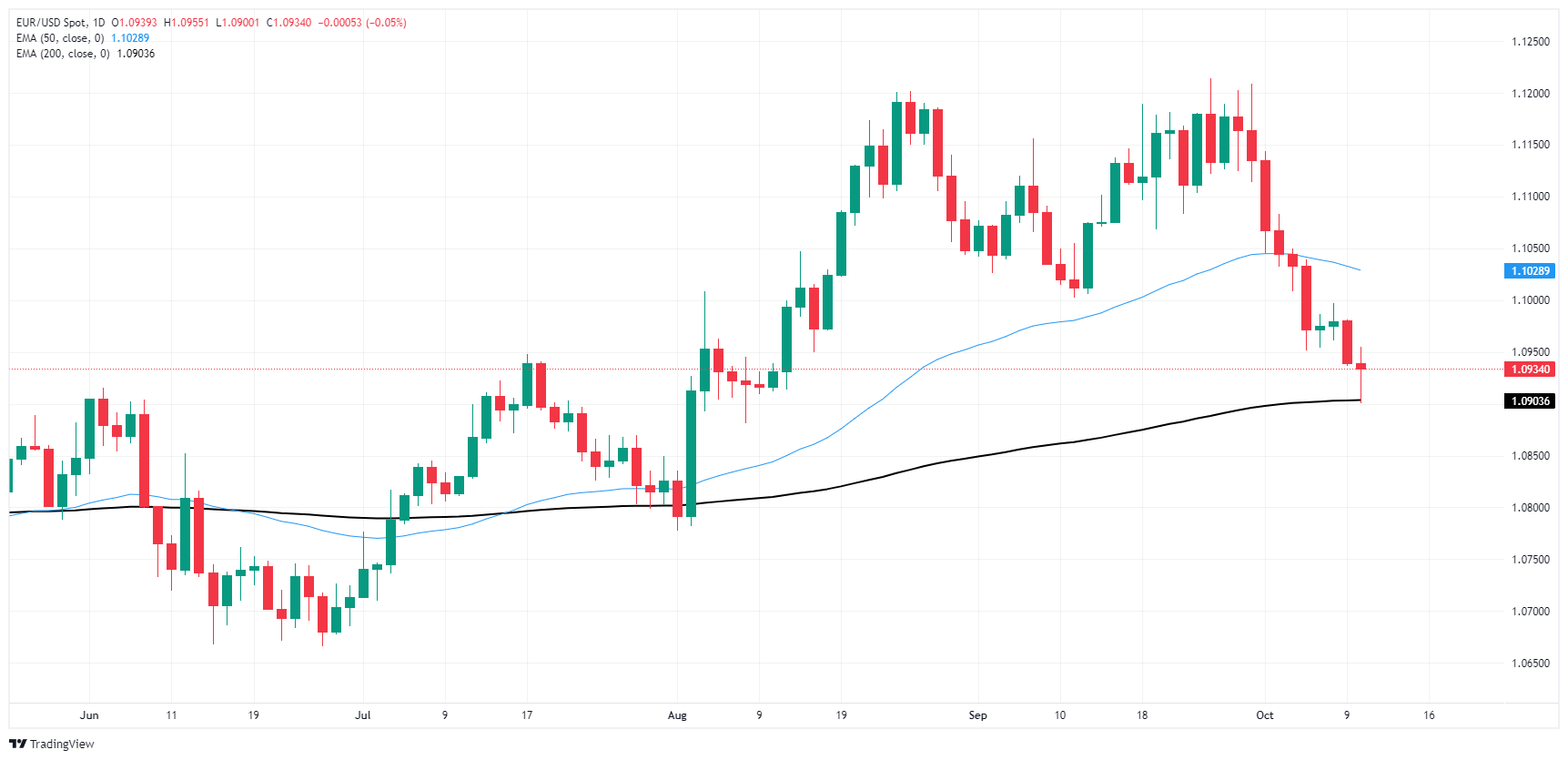- EUR/USD tested lower levels on Thursday, encountering the 200-day EMA.
- Euro data remains thin this week, leaving Fiber at the mercy of US data.
- Coming Friday: US PPI inflation, UoM consumer sentiment figures.
EUR/USD managed to maintain slight traction on the chart north of the 1.9000 area. The Fiber ended up closing lower, but recovered enough to pull back from a deeper test of the 200-day EMA near the 1.0900 area.
US headline CPI inflation fell less than expected in the year ending in September, declining from 2.5% to 2.4%. Median market forecasts had predicted a figure of 2.4% year-on-year. On the other hand, US core CPI inflation increased year-on-year in September, rising to 3.3% from 3.2% previously.
Initial jobless claims in the US unexpectedly rose in the week ending October 4, rising to 258,000 week-over-week and reaching the highest rate of new jobless claimants since June 2023.
Mixed data impacting rates confused rate markets on Thursday. Rising unemployment numbers raise hopes for rate cuts as the Federal Reserve (Fed) seeks to keep the US labor market afloat, while still-high inflation makes it difficult for investors to expect a faster pace and depth of rate cuts.
Significant economic data from Europe is almost completely absent on Friday, leaving Fiber traders at the mercy of overall Dollar flows to close out the trading week.
US Producer Price Index (PPI) inflation will be released during the US market session. The September core PPI figure for the year ended September is expected to accelerate to 2.7% year-on-year from 2.4% last month.
The University of Michigan’s 5-year consumer inflation expectations for October will also be released on Friday, along with the UoM Consumer Sentiment Index. The UoM Sentiment Index is expected to rise to 70.8 from 70.1, while the 5-year consumer sentiment expectations failed to forecast a figure, although the indicator rose in the previous month.
EUR/USD Price Forecast
The EUR/USD pair is trading around 1.09343, seeing a slight drop of 0.05% on the day as selling pressure continues to weigh on the currency pair. The price action is testing the 200-day exponential moving average (EMA) at 1.09036, a critical support level that could determine the pair’s next directional move. A break below this level could accelerate the downward momentum, potentially opening the door for further declines towards the 1.08500 level, a key psychological barrier. The 50-day EMA, currently at 1.10289, has now become a resistance level after the recent bearish break below it.
The overall trend appears to be shifting towards a more bearish near-term outlook. The sharp decline from the recent highs near 1.1200 indicates that the bullish momentum has largely faded. The price has consistently printed lower highs and lower lows, signaling a clear bearish trend. Traders will likely keep an eye on how the pair reacts around the 200-day EMA in the coming sessions, as a sustained move below this level could confirm a broader shift in market sentiment to the downside.
In a broader context, the EUR/USD price action reflects a market that is increasingly sensitive to economic data releases and central bank decisions. The pair’s recent decline coincides with a stronger US dollar, driven by expectations of tighter monetary policy from the Federal Reserve. Eurozone economic data, such as inflation and growth figures, will be key in determining whether the euro can find support at current levels or if further downside risks will materialize. Traders should keep an eye out for any reversal signs, but for now, the technical setup points to additional weakness.
EUR/USD Daily Chart
The Euro FAQs
The Euro is the currency of the 20 countries of the European Union that belong to the euro zone. It is the second most traded currency in the world, behind the US dollar. In 2022, it accounted for 31% of all foreign exchange transactions, with an average daily volume of more than $2.2 trillion per day. EUR/USD is the most traded currency pair in the world, accounting for an estimated 30% of all transactions, followed by EUR/JPY (4%), EUR/GBP (3%) and EUR/AUD (2% ).
The European Central Bank (ECB), headquartered in Frankfurt, Germany, is the reserve bank of the euro zone. The ECB sets interest rates and manages monetary policy The ECB’s main mandate is to maintain price stability, which means controlling inflation or stimulating growth. Its main instrument is to raise or lower interest rates. Relatively high interest rates – or the expectation of higher rates – tend to benefit the Euro and vice versa. The Governing Council of the ECB takes monetary policy decisions at meetings held eight times a year. Decisions are made by the heads of the eurozone’s national banks and six permanent members, including ECB President Christine Lagarde.
Eurozone inflation data, measured by the Harmonized Index of Consumer Prices (HICP), are an important econometric data for the euro. If inflation rises more than expected, especially if it exceeds the 2% target set by the ECB, it is forced to raise interest rates to bring it back under control. Relatively high interest rates compared to their peers tend to benefit the Euro, as it makes the region more attractive as a place for global investors to park their money.
Data releases measure the health of the economy and can influence the Euro. Indicators such as GDP, manufacturing and services PMIs, employment and consumer sentiment surveys can influence the direction of the single currency. A strong economy is good for the Euro. Not only does it attract more foreign investment, but it may encourage the ECB to raise interest rates, which will directly strengthen the Euro. Conversely, if economic data is weak, the Euro is likely to fall. The economic data for the four largest economies in the eurozone (Germany, France, Italy and Spain) are especially significant, as they represent 75% of the eurozone economy.
Another important release for the euro is the trade balance. This indicator measures the difference between what a country earns from its exports and what it spends on imports during a given period. If a country produces highly sought-after export products, its currency will appreciate due to the additional demand created by foreign buyers wishing to purchase these goods. Therefore, a positive net trade balance strengthens a currency and vice versa for a negative balance.
Source: Fx Street
I am Joshua Winder, a senior-level journalist and editor at World Stock Market. I specialize in covering news related to the stock market and economic trends. With more than 8 years of experience in this field, I have become an expert in financial reporting.







